Commonwealth realm
A Commonwealth realm is a sovereign state which has Elizabeth II as its monarch and head of state. Each realm functions as an independent co-equal kingdom from the other realms.
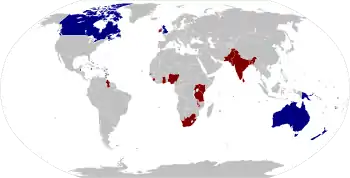
In 1952, Elizabeth II was the monarch and head of state of seven independent states—the United Kingdom, Canada, Australia, New Zealand, South Africa, Pakistan and Ceylon. Since then, new realms have been created through independence of former colonies and dependencies and some realms have become republics. As of 2021, there are 16 Commonwealth realms: Antigua and Barbuda, Australia, The Bahamas, Barbados, Belize, Canada, Grenada, Jamaica, New Zealand, Papua New Guinea, Saint Kitts and Nevis, Saint Lucia, Saint Vincent and the Grenadines, the Solomon Islands, Tuvalu, and the United Kingdom. All are members of the Commonwealth of Nations, an intergovernmental organisation of 54 independent member states. All Commonwealth members are independent sovereign states, whether they are Commonwealth realms or not.
Current realms
There are 16 Commonwealth realms currently with a combined area (excluding the Antarctic claims) of 18.7 million km2 (7.2 million mi2)[1] and a population of around 151 million,[2] of which all but about two million live in the six most populous: the United Kingdom, Canada, Australia, Papua New Guinea, New Zealand, and Jamaica.
| Country[Note 1] | Population[3][4](2018) | Monarchy | Date [Note 2] |
Governor General | Prime Minister | Queen's title | Sovereign's royal standard |
|---|---|---|---|---|---|---|---|
| 96,286 | Monarchy of Antigua and Barbuda | 1981 | Rodney Williams | Gaston Browne | Elizabeth the Second, by the Grace of God, Queen of Antigua and Barbuda and of Her other Realms and Territories, Head of the Commonwealth. | None | |
| 24,898,152 | Monarchy of Australia | 1901 | David Hurley | Scott Morrison | Elizabeth the Second, by the Grace of God Queen of Australia and Her other Realms and Territories, Head of the Commonwealth. | ||
| 385,637 | Monarchy of the Bahamas | 1973 | Cornelius A Smith | Hubert Minnis | Elizabeth the Second, by the Grace of God, Queen of the Commonwealth of The Bahamas and of Her other Realms and Territories, Head of the Commonwealth. | None | |
| 286,641 | Monarchy of Barbados | 1966 | Sandra Mason | Mia Mottley | Elizabeth the Second, by the Grace of God, Queen of Barbados and of Her other Realms and Territories, Head of the Commonwealth | ||
| 383,071 | Monarchy of Belize | 1981 | Colville Young | Johnny Briceño | Elizabeth the Second, by the Grace of God, Queen of Belize and of Her Other Realms and Territories, Head of the Commonwealth | None | |
| 37,064,562 | Monarchy of Canada | 1867 | Vacant | Justin Trudeau | English: Elizabeth the Second, by the Grace of God of the United Kingdom, Canada and of Her other Realms and Territories Queen, Head of the Commonwealth, Defender of the Faith French: Elizabeth Deux, par la grâce de Dieu Reine du Royaume-Uni, du Canada et de ses autres royaumes et territoires, Chef du Commonwealth, Défenseur de la Foi[5] |
||
| 111,454 | Monarchy of Grenada | 1974 | Cecile La Grenade | Keith Mitchell | Elizabeth the Second, by the Grace of God, Queen of the United Kingdom of Great Britain and Northern Ireland and of Grenada and Her other Realms and Territories, Head of the Commonwealth | None | |
| 2,934,847 | Monarchy of Jamaica | 1962 | Patrick Allen | Andrew Holness | Elizabeth the Second, by the Grace of God, Queen of Jamaica and of Her other Realms and Territories, Head of the Commonwealth | ||
| 4,743,131 | Monarchy of New Zealand | 1907 | Patsy Reddy | Jacinda Ardern | Elizabeth the Second, by the Grace of God Queen of New Zealand and Her Other Realms and Territories, Head of the Commonwealth, Defender of the Faith[6] | ||
| 8,606,323 | Monarchy of Papua New Guinea | 1975 | Bob Dadae | James Marape | Elizabeth the Second, Queen of Papua New Guinea and Her other Realms and Territories, Head of the Commonwealth[7] | None | |
| 52,441 | Monarchy of Saint Kitts and Nevis | 1983 | Tapley Seaton | Timothy Harris | Elizabeth the Second, by the Grace of God, Queen of Saint Christopher and Nevis and of Her other Realms and Territories, Head of the Commonwealth | None | |
| 181,889 | Monarchy of Saint Lucia | 1979 | Neville Senac | Allen Chastanet | Elizabeth the Second, by the Grace of God, Queen of Saint Lucia and of Her other Realms and Territories, Head of the Commonwealth | None | |
| 110,211 | Monarchy of Saint Vincent and the Grenadines | 1979 | Susan Dougan | Ralph Gonsalves | Elizabeth the Second, by the Grace of God, Queen of Saint Vincent and the Grenadines and of Her other Realms and Territories, Head of the Commonwealth | None | |
| 652,857 | Monarchy of Solomon Islands | 1978 | David Vunagi | Manasseh Sogavare | Elizabeth the Second, Queen of Solomon Islands and of Her other Realms and Territories, Head of the Commonwealth | None | |
| 11,508 | Monarchy of Tuvalu | 1978 | Iakoba Italeli | Kausea Natano | Elizabeth the Second, by the Grace of God, Queen of Tuvalu and of Her other Realms and Territories, Head of the Commonwealth | None | |
| 67,141,684 | Monarchy of the United Kingdom | 1801 | Boris Johnson | English: Elizabeth the Second, by the Grace of God of the United Kingdom of Great Britain and Northern Ireland and of Her other Realms and Territories Queen, Head of the Commonwealth, Defender of the Faith Latin: Elizabeth Secunda Dei Gratia Britanniarum Regnorumque Suorum Ceterorum Regina Consortionis Populorum Princeps Fidei Defensor[8] |
|
- The flags shown are the current national flags of the Commonwealth realms.
- Dates indicate the year each country became a dominion or Commonwealth realm.
- Barbados plans to remove the Queen as head of the state and become a republic by November 2021.
- The Cook Islands and Niue are under the sovereignty of the Queen of New Zealand as self-governing states in free association with New Zealand. New Zealand and its associated states, along with Tokelau and the Ross Dependency, compose the Realm of New Zealand.
- Guernsey, the Isle of Man, and Jersey—the Crown dependencies—are self-governing possessions of the British Crown, under the sovereignty of the Queen of the United Kingdom. Together with the UK, these comprise the British Islands.
Relationship of the realms
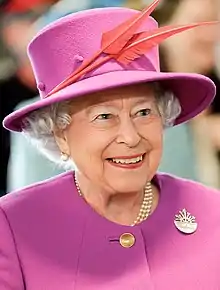
The Commonwealth realms are sovereign states. They are united only in their voluntary connection with the institution of the monarchy,[9] the succession, and the Queen herself; the person of the sovereign and the Crown were said in 1936 to be "the most important and vital link" between the dominions.[10] Political scientist Peter Boyce called this grouping of countries associated in this manner "an achievement without parallel in the history of international relations or constitutional law."[11] Terms such as personal union,[12][13][14][15][16][17] a form of personal union,[† 1][19] and shared monarchy,[20] among others,[† 2][23] have all been advanced as definitions since the beginning of the Commonwealth itself, though there has been no agreement on which term is most accurate,[22][23] or even whether personal union is applicable at all.[† 3][25]
Under the Balfour Declaration of 1926 dominions were proclaimed as considered "equal in status, in no way subordinate one to another in any aspect of their domestic or external affairs, though united by a common allegiance to the Crown"[26][9][27][28][29][30] and the monarch is "equally, officially, and explicitly [monarch] of separate, autonomous realms".[9][27][31][29] Andrew Michie wrote in 1952 that "Elizabeth II embodies in her own person many monarchies: she is Queen of Great Britain, but she is equally Queen of Canada, Australia, New Zealand, Pakistan, South Africa, and Ceylon... it is now possible for Elizabeth II to be, in practice as well as theory, equally Queen in all her realms."[32] Still, Boyce holds the contrary opinion that the crowns of all the non-British realms are "derivative, if not subordinate" to the crown of the United Kingdom.[33]
Since each realm has the same person as its monarch, the diplomatic practice of exchanging ambassadors with letters of credence and recall from one head of state to another does not apply. Diplomatic relations between the Commonwealth realms are thus at a cabinet level only and high commissioners are exchanged between realms (though all other countries in the Commonwealth of Nations also follow this same practice, but for traditional reasons). A high commissioner's full title will thus be High Commissioner for Her Majesty's Government in [Country]. For certain ceremonies, the order of precedence for the realms' high commissioners or national flags is set according to the chronological order of, first, when the country became a dominion and then the date on which the country gained independence.[34]
.jpg.webp)
Conflicts of interest have arisen from this relationship amongst independent states. Some have been minor diplomatic matters, such as the monarch expressing on the advice of one of her cabinets views that counter those of another of her cabinets.[† 4] More serious issues have arisen with respect to armed conflict, where the monarch, as head of state of two different realms, may be simultaneously at war and at peace with a third country, or even at war with herself as head of two hostile nations.[† 5]
The Crown in the Commonwealth realms
The evolution of dominions into realms has resulted in the Crown having both a shared and a separate character, with the one individual being equally monarch of each state and acting as such in right of a particular realm as a distinct legal person guided only by the advice of the cabinet of that jurisdiction.[9][27][37][38][39][40] This means that in different contexts the term Crown may refer to the extra-national institution associating all 16 countries, or to the Crown in each realm considered separately.[† 6] The monarchy is therefore no longer an exclusively British institution,[37][40] having become "domesticated" in each of the realms.[28]
From a cultural standpoint, the sovereign's name and image and other royal symbols unique to each nation are visible in the emblems and insignia of governmental institutions and militia. The Queen's effigy, for example, appears on coins and banknotes in some countries, and an oath of allegiance to the Queen is usually required from politicians, judges, military members and new citizens. By 1959, it was being asserted by Buckingham Palace officials that the Queen was "equally at home in all her realms".[41]
Royal succession and regency
To guarantee the continuity of multiple states sharing the same person as monarch, the preamble of the Statute of Westminster 1931 laid out a convention that any alteration to the line of succession in any one country must be voluntarily approved by the parliaments of all the realms.[† 7][42] This convention was first applied in 1936 when the British government conferred with the dominion governments during the Edward VIII abdication crisis. Prime Minister of Canada William Lyon Mackenzie King pointed out that the Statute of Westminster required Canada's request and consent to any legislation passed by the British parliament before it could become part of Canada's laws and affect the line of succession in Canada.[43] Sir Maurice Gwyer, first parliamentary counsel in the UK, reflected this position, stating that the Act of Settlement was a part of the law in each dominion.[43] Though today the Statute of Westminster is law only in Canada, Australia, and the United Kingdom,[44] the convention of approval from the other realms was reasserted by the Perth Agreement of 2011, in which all 16 countries agreed in principle to change the succession rule to absolute primogeniture, to remove the restriction on the monarch being married to a Catholic, and to reduce the number of members of the Royal Family who need the monarch's permission to marry. These changes came into effect on 26 March 2015. Alternatively, a Commonwealth realm may choose to cease being such by making its throne the inheritance of a different royal house or by becoming a republic, actions to which, though they alter the country's royal succession, the convention does not apply.[45]
Agreement among the realms does not, however, mean the succession laws cannot diverge. During the abdication crisis in 1936, the United Kingdom passed His Majesty's Declaration of Abdication Act with the approval of the parliament of Australia and the governments of the remaining dominions. (Canada, New Zealand, and South Africa gave parliamentary assent later.[46]) The Act effected Edward's abdication in the United Kingdom on 11 December; as the Canadian government had requested and consented to the Act becoming part of Canadian law, and Australia and New Zealand had then not yet adopted the Statute of Westminster, the abdication took place in those countries on the same day. The parliament of South Africa, however, passed its own legislation—His Majesty King Edward the Eighth's Abdication Act, 1937—which backdated the abdication there to 10 December. The Irish Free State recognised the king's abdication with the Executive Authority (External Relations) Act 1936 on 12 December.[46][47][48] According to Anne Twomey, this demonstrated "the divisibility of the Crown in the personal, as well as the political, sense."[46] For E H Coghill, writing as early as 1937, it proved that the convention of a common line of succession "is not of imperative force".[49] and Kenneth John Scott asserted in 1962 that it ended the "convention that statutory uniformity on these subjects would be maintained in the parts of the Commonwealth that continued to owe allegiance to the Crown".[50]
Today, some realms govern succession by their own domestic laws, while others, either by written clauses in their constitution or by convention, stipulate that whoever is monarch of the United Kingdom is automatically also monarch of that realm. It is generally agreed that any unilateral alteration of succession by the UK would not have effect in all the realms.[† 8]
Following the accession of George VI to the throne, the United Kingdom created legislation that provided for a regency in the event that the monarch was not of age or incapacitated. Though input was sought from the dominions on this matter, all declined to make themselves bound by the British legislation, feeling instead that the governors-general could carry out royal functions in place of a debilitated or underage sovereign.[53] Tuvalu later incorporated this principle into its constitution.[54] New Zealand included in its Constitution Act 1986 a clause specifying that, should a regent be installed in the United Kingdom, that individual would carry out the functions of the monarch of New Zealand.[55]
Monarch's role in the realms
The monarch holds the highest position in each Commonwealth realm and may perform such functions as issuing executive orders, establishing or dismissing a government, commanding the military forces, and creating and administering laws.[56]
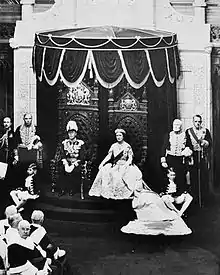
The sovereign resides predominantly in her oldest realm, the United Kingdom, and thus carries out her duties there mostly in person. The Queen appoints viceroys to perform most of the royal constitutional and ceremonial duties on her behalf in the other realms: in each, a governor-general as her personal national representative, as well as a governor as her representative in each of the Australian states. These appointments are all made on the advice of the prime minister of the country or the premier of the state concerned, though this process may have additional requirements.[† 9] In certain other cases, the extent of which varies from realm to realm, specific additional powers are reserved exclusively for the monarch—such as the appointment of extra senators to the Canadian Senate, the creation of honours, or the issuance of letters patent—and on occasions of national importance, the Queen may be advised to perform in person her constitutional duties, such as granting Royal Assent or issuing a royal proclamation. Otherwise, all royal powers, including the Royal Prerogative, are carried out on behalf of the sovereign by the relevant viceroy, who, apart from those already mentioned, include a lieutenant governor in each province of Canada (appointed by the Governor General of Canada). In the United Kingdom, the Queen appoints Counsellors of State to perform her constitutional duties in her absence.
Similarly, the monarch will perform ceremonial duties in the Commonwealth realms to mark historically significant events.[57] Citizens in Commonwealth realms may request birthday or wedding anniversary messages to be sent from the sovereign. This is available for 100th, 105th, and beyond for birthdays; and 60th ("Diamond"), 65th, 70th ("Platinum"), and beyond for wedding anniversaries.[58]
Religious role of the monarch
It is solely in the United Kingdom that the Queen plays a role in organised religion. In England, she acts as the Supreme Governor of the Church of England and nominally appoints its bishops and archbishops. In Scotland, she swears an oath to uphold and protect the Church of Scotland and sends a Lord High Commissioner as her representative to meetings of the church's General Assembly, when she is not personally in attendance.[59]
Flags
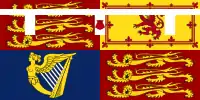
.svg.png.webp)
Some members of the royal family have different heraldic standards for use in the appropriate realm
The governors-general throughout the Commonwealth realms also each use a personal flag, which, like that of the sovereign, passes to each successive occupant of the office. Most feature a lion passant atop a St. Edward's royal crown with the name of the country across a scroll underneath, all on a blue background. The two exceptions are those of, since 1981, Canada (bearing on a blue background the crest of the Royal Coat of Arms of Canada) and, since 2008, New Zealand (a St. Edward's Crown above the shield of the Coat of arms of New Zealand). The lieutenant governors of the Canadian provinces each have their own personal standards, as do the governors of the Australian states.
Historical development
Dominions emerge
The possibility that a colony within the British Empire might become a new kingdom was first mooted in the 1860s, when it was proposed that the British North American territories of Nova Scotia, New Brunswick, and the Province of Canada unite as a confederation that might be known as the Kingdom of Canada.[60][61][62]
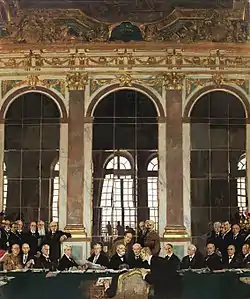
Although the dominions were capable of governing themselves internally, they technically remained—especially in regard to foreign policy and defence—subject to British authority, wherein the Governor-General of each dominion represented the British monarch-in-Council reigning over these territories as a single imperial domain. It was commonly held in some circles that the Crown was a monolithic element throughout all the monarch's territories; A.H. Lefroy wrote in 1918 that "the Crown is to be considered as one and indivisible throughout the Empire; and cannot be severed into as many kingships as there are dominions, and self-governing colonies."[63] This unitary model began to erode, however, when the dominions gained more international prominence as a result of their participation and sacrifice in the First World War, in 1919 prompting Canadian prime minister Sir Robert Borden and South African minister of defence Jan Smuts to demand that the dominions be given at the Versailles Conference full recognition as "autonomous nations of an Imperial Commonwealth." The immediate result was that, though the King signed as High Contracting Party for the empire as a whole,[64] the dominions were also separate signatories to the Treaty of Versailles, as well as, together with India, founding members of the League of Nations. In 1921 the Prime Minister of the United Kingdom David Lloyd George stated that the "British Dominions have now been accepted fully into the community of nations."[65]
Balfour Declaration
The pace of independence increased in the 1920s, led by Canada, which exchanged envoys with the United States in 1920 and concluded the Halibut Treaty in its own right in 1923.[64] In the Chanak crisis of 1922, the Canadian government insisted that its course of action would be determined by the Canadian parliament,[66] not the British government, and, by 1925, the dominions felt confident enough to refuse to be bound by Britain's adherence to the Treaty of Locarno.[67] The Viscount Haldane said in 1919 that in Australia the Crown "acts in self-governing States on the initiative and advice of its own ministers in these States."[68][64][69]
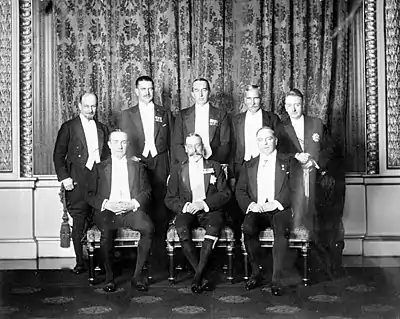
Another catalyst for change came in 1926, when Field Marshal the Lord Byng of Vimy, then Governor General of Canada, refused the advice of his prime minister (William Lyon Mackenzie King) in what came to be known colloquially as the King–Byng Affair.[70] Mackenzie King, after resigning and then being reappointed as prime minister some months later, pushed at the Imperial Conference of 1926 for a reorganisation of the way the dominions related to the British government, resulting in the Balfour Declaration, which declared formally that the dominions were fully autonomous and equal in status to the United Kingdom.[71] What this meant in practice was not at the time worked out; conflicting views existed, some in the United Kingdom not wishing to see a fracturing of the sacred unity of the Crown throughout the empire, and some in the dominions not wishing to see their jurisdiction have to take on the full brunt of diplomatic and military responsibilities.[28]
What did follow was that the dominion governments gained an equal status with the United Kingdom, a separate and direct relationship with the monarch, without the British Cabinet acting as an intermediary, and the governors-general now acted solely as a personal representative of the sovereign in right of that dominion.[† 12][73] Though no formal mechanism for tendering advice to the monarch had yet been established—former Prime Minister of Australia Billy Hughes theorised that the dominion cabinets would provide informal direction and the British Cabinet would offer formal advice[74]—the concepts were first put into legal practice with the passage in 1927 of the Royal and Parliamentary Titles Act, which implicitly recognised the Irish Free State as separate from the UK, and the King as king of each dominion uniquely, rather than as the British king in each dominion. At the same time, terminology in foreign relations was altered to demonstrate the independent status of the dominions, such as the dropping of the term "Britannic" from the King's style outside of the United Kingdom.[75] Then, in 1930 George V's Australian ministers employed a practice adopted by resolution at that year's Imperial Conference,[64] directly advising the King to appoint Sir Isaac Isaacs as the Australian governor-general.
Statute of Westminster
These new developments were explicitly codified in 1931 with the passage of the Statute of Westminster, through which Canada, the Union of South Africa, and the Irish Free State all immediately obtained formal legislative independence from the UK, while in the other dominions adoption of the statute was subject to ratification by the dominion's parliament. Australia and New Zealand did so in 1942 and 1947, respectively, with the former's ratification back-dated to 1939, while Newfoundland never ratified the bill and reverted to direct British rule in 1934. As a result, the parliament at Westminster was unable to legislate for any Dominion unless requested to do so,[64] although the Judicial Committee of the Privy Council was left available as the last court of appeal for some Dominions.[76] Specific attention was given in the statute's preamble to royal succession, outlining that no changes to that line could be made by the parliament of the United Kingdom or that of any dominion without the assent of all the other parliaments of the UK and dominions, an arrangement a justice of the Ontario Superior Court in 2003 likened to "a treaty among the Commonwealth countries to share the monarchy under the existing rules and not to change the rules without the agreement of all signatories."[77]
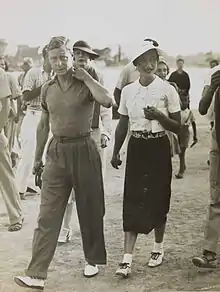
This was all met with only minor trepidation, either before or at the time,[† 13] and the government of Ireland was confident that the relationship of these independent countries under the Crown would function as a personal union,[19] akin to that which had earlier existed between the United Kingdom and Hanover (1801 to 1837), or between England and Scotland (1603 to 1707). Its first test came, though, with the abdication of King Edward VIII in 1936,[64] for which it was necessary to gain the consent of the governments of all the dominions and the request and consent of the Canadian government, as well as separate legislation in South Africa and the Irish Free State, before the resignation could take place across the Commonwealth.[79]
The civil division of the Court of Appeal of England and Wales later found in 1982 that the British parliament could have legislated for a dominion simply by including in any new law a clause claiming the dominion cabinet had requested and approved of the act, whether that was true or not.[80] Further, the British parliament was not obliged to fulfil a dominion's request for legislative change. Regardless, in 1935 the British parliament refused to consider the result of the Western Australian secession referendum of 1933 without the approval of the Australian federal government or parliament. In 1937, the Appeal Division of the Supreme Court of South Africa ruled unanimously that a repeal of the Statute of Westminster in the United Kingdom would have no effect in South Africa, stating: "We cannot take this argument seriously. Freedom once conferred cannot be revoked."[81] Others in Canada upheld the same position.[64]
Fully sovereign dominions
At the 1932 British Empire Economic Conference, delegates from the United Kingdom, led by Stanley Baldwin (then Lord President of the Council),[82] hoped to establish a system of free trade within the British Commonwealth, to promote unity within the British Empire and to assure Britain's position as a world power. The idea was controversial, as it pitted proponents of imperial trade with those who sought a general policy of trade liberalisation with all nations. The dominions, particularly Canada, were also adamantly against dispensing with their import tariffs,[83] which "dispelled any romantic notions of a 'United Empire'."[82] The meeting, however, did produce a five-year trade agreement based upon a policy, first conceived in the 1900s,[84] of Imperial Preference: the countries retained their import tariffs, but lowered these for other Commonwealth countries.[83][85]
During his tenure as Governor General of Canada, Lord Tweedsmuir urged the organisation of a royal tour of the country by King George VI, so that he might not only appear in person before his people, but also personally perform constitutional duties and pay a state visit to the United States as king of Canada.[86] While the idea was embraced in Canada as a way to "translate the Statute of Westminster into the actualities of a tour," throughout the planning of the trip that took place in 1939, the British authorities resisted at numerous points the idea that the King be attended by his Canadian ministers instead of his British ones.[87] The Canadian prime minister (still Mackenzie King) was ultimately successful, however, in being the minister in attendance, and the King did in public throughout the trip ultimately act solely in his capacity as the Canadian monarch. The status of the Crown was bolstered by Canada's reception of George VI.[86]
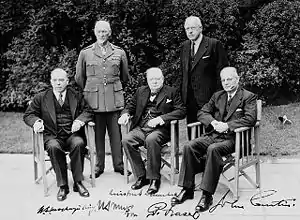
When the Second World War began, there was some uncertainty in the dominions about the ramifications of Britain's declaration of war against Adolf Hitler. Australia and New Zealand had not yet ratified the Statute of Westminster; the Australian prime minister, Robert Menzies, considered the government bound by the British declaration of war,[88][89][90] while New Zealand coordinated a declaration of war to be made simultaneously with Britain's.[91] As late as 1937, some scholars were still of the mind that, when it came to declarations of war, if the King signed, he did so as king of the empire as a whole; at that time, W. Kennedy wrote: "in the final test of sovereignty—that of war—Canada is not a sovereign state... and it remains as true in 1937 as it was in 1914 that when the Crown is at war, Canada is legally at war,"[92] and, one year later, Arthur Berriedale Keith argued that "issues of war or neutrality still are decided on the final authority of the British Cabinet."[93] In 1939, however, Canada and South Africa made separate proclamations of war against Germany a few days after the UK's. Their example was followed more consistently by the other realms as further war was declared against Italy, Romania, Hungary, Finland, and Japan.[64] Ireland remained neutral.[90] At the war's end, it was said by F.R. Scott that "it is firmly established as a basic constitutional principle that, so far as relates to Canada, the King is regulated by Canadian law and must act only on the advice and responsibility of Canadian ministers."[94]
Post-war evolution
Within three years following the end of the Second World War, India, Pakistan, and Ceylon became independent dominions within the Commonwealth. India would soon move to a republican form of government. Unlike the Republic of Ireland and Burma, however, there was no desire on the part of India to leave the Commonwealth, prompting a Commonwealth Conference and the London Declaration in April 1949, which entrenched the idea that republics be allowed in the Commonwealth so long as they recognised King George VI as Head of the Commonwealth and the "symbol of the free association of its independent member nations".[95]
As these constitutional developments were taking place, the dominion and British governments became increasingly concerned with how to represent the more commonly accepted notion that there was no distinction between the sovereign's role in the United Kingdom and his or her position in any of the dominions. Thus, at the 1948 Prime Ministers' Conference the term dominion was avoided in favour of Commonwealth country, to avoid the subordination implied by the older designation.[96]
From the accession of Queen Elizabeth II

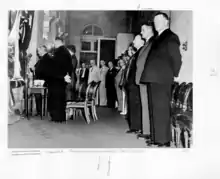
The British proclamation of Elizabeth II's accession to the throne in 1952 used the term "Realms", whereas previously the singular "Realm" was used to cover all "Dominions of the Crown", or the British Empire as a singular unit.[97]
The Commonwealth's prime ministers discussed the matter of the new monarch's title, with St. Laurent stating at the 1953 Commonwealth Prime Ministers' Conference that it was important to agree on a format that would "emphasise the fact that the Queen is Queen of Canada, regardless of her sovereignty over other Commonwealth countries."[38] The result was a new Royal Style and Titles Act being passed in each of the seven realms then existing (excluding Pakistan), which all identically gave formal recognition to the separateness and equality of the countries involved, and replaced the phrase "British Dominions Beyond the Seas" with "Her Other Realms and Territories", the latter using the word realm in place of dominion. Further, at her coronation, Elizabeth II's oath contained a provision requiring her to promise to govern according to the rules and customs of the realms, naming each one separately. The change in perspective was summed up by Patrick Gordon Walker's statement in the British House of Commons: "We in this country have to abandon... any sense of property in the Crown. The Queen, now, clearly, explicitly and according to title, belongs equally to all her realms and to the Commonwealth as a whole."[37] In the same period, Walker also suggested to the British parliament that the Queen should annually spend an equal amount of time in each of her realms. Lord Altrincham, who in 1957 criticised Queen Elizabeth II for having a court that encompassed mostly Britain and not the Commonwealth as a whole,[98] was in favour of the idea, but it did not attract wide support.[99] Another thought raised was that viceregal appointments should become trans-Commonwealth; the governor-general of Australia would be someone from South Africa, the governor-general of Ceylon would come from New Zealand, and so on. The prime ministers of Canada and Australia, John Diefenbaker and Robert Menzies, respectively, were sympathetic to the concept, but, again, it was never put into practice.[100]
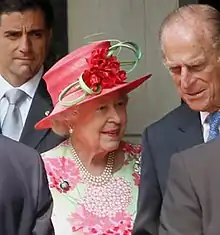
On 6 July 2010, Elizabeth II addressed the United Nations in New York City as queen of all 16 Commonwealth realms.[101] The following year, Portia Simpson-Miller, the Prime Minister of Jamaica, spoke of a desire to make that country a republic,[102][103] while Alex Salmond, the First Minister of Scotland and leader of the Scottish National Party (which favours Scottish independence), stated an independent Scotland "would still share a monarchy with... the UK, just as... 16 [sic] other Commonwealth countries do now."[104] Dennis Canavan, leader of Yes Scotland, disagreed and said a separate, post-independence referendum should be held on the matter.[105]
Following the Perth Agreement of 2011, the Commonwealth realms, in accordance with convention, together engaged in a process of amending the common line of succession according to each country's constitution, to ensure the order would continue to be identical in every realm. In legislative debates in the United Kingdom, the term Commonwealth realm was employed.[106][107]
Former realms
List of states
- Renamed Sri Lanka upon becoming a republic. The Ceylonese flag changed in 1951.
- See also: Irish head of state from 1936 to 1949.
- The South Africa flag changed in 1912, and again in 1928.
- Now a part of Tanzania.
In addition to the states listed above, the Dominion of Newfoundland was a dominion when the Statute of Westminster 1931 was given royal assent but effectively lost that status in 1934, without ever having assented to the Statute of Westminster, and before the term Commonwealth realm ever came into use. Due to a domestic financial and political crisis, the Newfoundland legislature petitioned the UK to suspend dominion status, the UK parliament passed the Newfoundland Act 1933, and direct rule was implemented in 1934. Rather than reclaiming dominion status after the Second World War, it became a province of Canada in 1949.[108]
Republican referendums
Six Commonwealth realms and Dominions have held referendums to consider whether they should become republics. As of January 2020, of the eight referendums held, three have been successful: in Ghana, in South Africa and the second referendum in Gambia. Referendums which rejected the proposal were held in Australia, twice in Tuvalu, and in Saint Vincent and the Grenadines. Interest in holding a second referendum was expressed in Australia in 2010.[109] During the 2020 Jamaican general election the People's National Party promised to hold a referendum on becoming a republic within 18 months if it won the election.[110] and polls suggested that 55% of Jamaicans desired the country become a republic.[111] However, the ruling Jamaica Labour Party, which had in 2016 promised a referendum but not carried one out, was re-elected.[112]
| Year held | Country | Yes | No | Margin of victory (%) | Republic |
|---|---|---|---|---|---|
| 1960 | 1,008,740 (88.49%) | 131,145 (11.51%) | 877,595 (77%) | ||
| 1960 | 850,458 (52.29%) | 775,878 (47.71%) | 74,580 (5%) | ||
| 1965 | 61,563 (65.85%) | 31,921 (34.15%) | N/A1 | ||
| 1970 | 84,968 (70.45%) | 35,638 (29.55%) | 49,330 (41%) | ||
| 1986 | 121 (5.34%) | 2,144 (94.66%) | 2,023 (89%) | ||
| 1999 | 5,273,024 (45.13%) | 6,410,787 (54.87%) | 1,137,763 (10%) | ||
| 2008 | 679 (35.02%) | 1,260 (64.98%) | 581 (30%) | ||
| 2009 | 22,646 (43.71%) | 29,167 (55.29%) | 6,521 (12%) | ||
- Notes
- ^ In this referendum the "yes" votes failed to reach the required two-thirds (66%) total, therefore the proposal was rejected.
See also
Notes
- F.R. Scott stated: "The common kinship within the British group today establishes a form of personal union, the members of which are legally capable of following different international policies even in time of war."[18]
- W.Y Elliott stated: If a personal union be chosen, the Crown will be forced to act on the king's own discretion [and] since personal discretion is a modern monarch is unthinkable, the only alternative would be a league of states with a common but symbolic crown",[21] and Alexander N. Sack stated: "Whatever the future development of the British Commonwealth may be [it] can be described as a that of associations or unions of States, as distinguished from 'personal' unions, on the one hand, and federal States, on the other.[22]
- J. D. B. Miller stated:[T]he survey concludes with an attempt to classify the Commonwealth. It is no longer a federation, nor a military alliance, nor a personal union.[24]
- During a British state visit to Jordan in 1984, Queen Elizabeth II made a speech expressing opinions of her British Cabinet that countered the views of her Australian Cabinet,[35] though the Queen was evidently not representing Australia at that time. Similarly, Elizabeth II undertook a visit to Latin America to promote British goods at the same time that a Canadian ministerial trip was underway in the same region to promote Canadian products.[36]
- On 3 September 1939, the United Kingdom declared war on Nazi Germany, but it was only on 6 September that, under the articles of the Statute of Westminster, the Union of South Africa did same, followed by Canada on 10 September. Therefore, from 3 to 10 September, King George VI, as king of the United Kingdom, South Africa and Canada, was both at war and at peace with Germany.
During the Indo-Pakistani War of 1947, George VI was head of state of both warring nations. In 1983, Elizabeth II was monarch of Grenada when her governor-general there requested the invasion of the country by a number of other Caribbean states, including some that were also realms of the Queen; an undertaking that was opposed by a number of Queen Elizabeth II's other governments, such as those of the United Kingdom, Canada, and Belize. - One Canadian constitutional scholar, Dr. Richard Toporoski, stated on this: "I am perfectly prepared to concede, even happily affirm, that the British Crown no longer exists in Canada, but that is because legal reality indicates to me that in one sense, the British Crown no longer exists in Britain: the Crown transcends Britain just as much as it does Canada. One can therefore speak of 'the British Crown' or 'the Canadian Crown' or indeed the 'Barbadian' or 'Tuvaluan' Crown, but what one will mean by the term is the Crown acting or expressing itself within the context of that particular jurisdiction".[40]
- See Sue v Hill.
- Noel Cox stated: "Any alteration by the United Kingdom Parliament in the law touching the succession to the throne would, except perhaps in the case of Papua New Guinea, be ineffective to alter the succession to the throne in respect of, and in accordance with the law of, any other independent member of the Commonwealth which was within the Queen's realms at the time of such alteration. Therefore it is more than mere constitutional convention that requires that the assent of the Parliament of each member of the Commonwealth within the Queen's realms be obtained in respect of any such alteration in the law."[51] Richard Toporoski similarly stated: "[I]f, let us say, an alteration were to be made in the United Kingdom to the Act of Settlement 1701, providing for the succession of the Crown. It is my opinion that the domestic constitutional law of Australia or Papua New Guinea, for example, would provide for the succession in those countries of the same person who became Sovereign of the United Kingdom ... If the British law were to be changed and we [Canada] did not change our law ... the Crown would be divided. The person provided for in the new law would become king or queen in at least some realms of the Commonwealth; Canada would continue on with the person who would have become monarch under the previous law ...[52]
- In the Solomon Islands and Tuvalu, the prime minister must consult the legislature in confidence; in Papua New Guinea, the governor-general is nominated to the Queen by a parliamentary vote.
- The Australian and South African prime ministers, Billy Hughes and Louis Botha, stand first and second from the right; the Canadian delegate, Sir George Foster, stands fourth from left. The representatives of New Zealand and Newfoundland are not shown.
- The figures in the photo are, back row, left to right: Walter Stanley Monroe, Prime Minister of Newfoundland; Gordon Coates, Prime Minister of New Zealand; Stanley Bruce, Prime Minister of Australia; James Hertzog, Prime Minister of South Africa, and W. T. Cosgrave, President of the Executive Council of the Irish Free State; front row, left to right: Stanley Baldwin, Prime Minister of the United Kingdom; the King; and William Lyon Mackenzie King, Prime Minister of Canada.
- The ministers in attendance at the Imperial Conference agreed that: "In our opinion it is an essential consequence of the equality of status existing among the members of the British Commonwealth of Nations that the Governor General of a Dominion is the representative of the Crown, holding in all essential respects the same position in relation to the administration of public affairs in the Dominion as is held by His Majesty the King in Great Britain, and that he is not the representative or agent of His Majesty's Government in Great Britain or of any Department of that Government".[72]
- P.E. Corbett in 1940 questioned whether there were any existing terms that could be used to describe any or all of the "possessions of the British Crown,"[23] while Scottish constitutional lawyer Arthur Berriedale Keith warned before 1930 that "the suggestion that the King can act directly on the advice of Dominion Ministers is a constitutional monstrosity, which would be fatal to the security of the position of the Crown."[78]
References
- Figures totalled from member state profiles at the Commonwealth of Nations secretariat, rounded to the nearest 100,000.
- "World Population Prospects - Population Division - United Nations". population.un.org.
- ""World Population prospects – Population division"". population.un.org. United Nations Department of Economic and Social Affairs, Population Division. Retrieved 9 November 2019.
- ""Overall total population" – World Population Prospects: The 2019 Revision" (xslx). population.un.org (custom data acquired via website). United Nations Department of Economic and Social Affairs, Population Division. Retrieved 9 November 2019.
- Loi sur les titres royaux. Ottawa: Queen's Printer for Canada. 1985. R.S., 1985, c. R-12. Archived from the original on 5 November 2013. Retrieved 3 May 2009.
- Royal Household. "The Queen and the Commonwealth > Queen and New Zealand". Royal Household. Archived from the original on 26 September 2013. Retrieved 18 August 2013.
- Constitution of the Independent State of Papua New Guinea, S.85, retrieved 22 May 2015
- Velde, François. "Royal Arms, Styles and Titles of Great Britain". Heraldica. François R Velde. Retrieved 24 January 2012.
- Trepanier, Peter (2004). "Some Visual Aspects of the Monarchical Tradition" (PDF). Canadian Parliamentary Review. 27 (2): 28. Retrieved 2 May 2009.
- Berriedale, Keith (1936), "The King and the Imperial Crown: The Powers and Duties of His Majesty", in Coates, Colin MacMillan (ed.), Majesty in Canada: essays on the role of royalty, Toronto: Dundurn Press Ltd. (published 2006), p. 12, ISBN 978-1-55002-586-6, retrieved 16 January 2011
- Boyce, Peter (2008). The Queen's Other Realms. Annandale: Federation Press. p. 1. ISBN 978-1-86287-700-9.
- Oppenheim, Lassa (1952). Lauterpacht, Hersch (ed.). International law: a treatise. 1. London: Longmans. p. 163. ISBN 978-1-58477-609-3. Retrieved 29 January 2010.
- Clerk of the House of Commons (1947). Debates: official report. 1. Ottawa: King's Printer for Canada. p. 591. Retrieved 29 January 2010.
- Coolidge, Archibald Cary; Armstrong, Hamilton Fish (1927). Foreign affairs, Volume 6. New York: Council on Foreign Relations. pp. 124–125, 127. Retrieved 7 November 2009.
- Library of Parliament (1947). Special war session, Volume 1. Ottawa: Queen's Printer for Canada. p. 591. Retrieved 7 November 2009.
- "Personal Union". Crowned Republic. Archived from the original on 18 November 2009. Retrieved 29 January 2010.
- Hudson, Wayne (2004). Restructuring Australia: Regionalism, Republicanism and Reform of the Nation-State. Sydney: Federation Press. p. 86. ISBN 9781862874923.
- Scott, F. R. (January 1944), "The End of Dominion Status", The American Journal of International Law, 38 (1): 34–49, doi:10.2307/2192530, JSTOR 2192530
- "Black v Chrétien: Suing a Minister of the Crown for Abuse of Power, Misfeasance in Public Office and Negligence". Murdoch University Electronic Journal of Law. 9 (3). September 2002. Retrieved 2 October 2008.
- Trepanier 2004, p. 27
- Elliott, W.Y (November 1930). "The Sovereignty of the British Dominions: Law Overtakes Practice". The American Political Science Review. 24 (4): 971–989. doi:10.2307/1946754. JSTOR 1946754.
- Sack, Alexander N.; Stewart, Robert B. (March 1940). "Treaty Relations of the British Commonwealth of Nations". University of Pennsylvania Law Review and American Law Register. 88 (5): 637–640. doi:10.2307/3308937. hdl:2027/mdp.39015062366508. JSTOR 3308937.
- Corbett, P. E. (1940). "The Status of the British Commonwealth in International Law". The University of Toronto Law Journal. 3 (2): 348–359. doi:10.2307/824318. JSTOR 824318.
- Miller, J.D.B (October 1959). "The Commonwealth in the World". The American Historical Review. 65 (1). doi:10.1086/ahr/65.1.111.
- Keith, Arthur Berriedale (1929). The sovereignty of the British dominions. New York: Macmillan and Co. Ltd. p. xvii. ISBN 978-0-8371-8668-9. Retrieved 7 November 2009.
- Balfour, Arthur (November 1926). "Imperial Conference 1926" (PDF). Balfour Declaration. London: Inter-Imperial Relations Committee. p. 3. E (I.R./26) Series. Retrieved 6 May 2009.
- Cox, Noel (19 October 2003), The Development of a Separate Crown in New Zealand (PDF), Auckland University of Technology, p. 18, archived from the original (PDF) on 15 July 2011, retrieved 3 January 2011
- Mallory, J.R. (August 1956). "Seals and Symbols: From Substance to Form in Commonwealth Equality". The Canadian Journal of Economics and Political Science. 22 (3): 281–291. ISSN 0008-4085. JSTOR 13843.
- Trepanier, Peter (2006), "A Not Unwilling Subject: Canada and Her Queen", in Coates, Colin MacMillan (ed.), Majesty in Canada: essays on the role of royalty, Toronto: Dundurn Press Ltd., p. 144, ISBN 978-1-55002-586-6, retrieved 11 June 2017
- Twomey, Anne (2006). The Chameleon Crown. Sydney: Federation Press. p. 81. ISBN 9781862876293.
- Michie, Allan Andrew (1952). The Crown and the People. London: Secker & Warburg. pp. 52, 369. Retrieved 11 June 2017.
- Michie 1952, p. 52
- Boyce 2008, p. 23
- "British Flag Protocol > Order for Commonwealth Events Held in the UK (but not the Commonwealth Games)". Flag Institute. Retrieved 1 October 2015.
- Cohen, Zelman (1995). "Further Reflections on an Australian Republic". Sir Robert Menzies Lecture Trust. Archived from the original (Lecture) on 28 September 2007. Retrieved 3 May 2009. Cite journal requires
|journal=(help) - Sharp, Mitchell (1994). Which Reminds Me..., A Memoir. Toronto: University of Toronto Press. p. 223. ISBN 978-0-8020-0545-8.
- Bogdanor, Vernon (12 February 1998), The Monarchy and the Constitution, New York: Oxford University Press, p. 288, ISBN 978-0-19-829334-7
- High Commissioner in United Kingdom (24 November 1952). "Royal Style and Titles". Documents on Canadian External Relations > Royal Style and Titles. 18 (2). DEA/50121-B-40. Archived from the original on 23 November 2011.
- Smy, William A. (2008). "Royal titles and styles". The Loyalist Gazette. XLVI (1). Archived from the original on 11 July 2012. Retrieved 3 January 2011.
- Toporoski, Richard. "The Invisible Crown". Monarchy Canada. Archived from the original on 9 February 2008. Retrieved 20 April 2008.
- Buckner, Phillip (2005). "The Last Great Royal Tour: Queen Elizabeth's 1959 Tour to Canada". In Buckner, Phillip (ed.). Canada and the End of Empire. Vancouver: UBC Press. p. 66. ISBN 978-0-7748-0915-3. Retrieved 24 October 2009.
- Statute of Westminster, 1931. Westminster: Her Majesty's Stationery Office. 11 December 1931. c. 4 (U.K.). Retrieved 22 May 2015.
- Anne Twomey (18 September 2014). Professor Anne Twomey – Succession to the Crown: foiled by Canada? (Digital video). London: University College London.
- Twomey, Anne (October 2011), Changing the Rules of Succession to the Throne, Sydney Law School, pp. 10–11, SSRN 1943287
- Twomey 2011, p. 12
- Twomey 2011, p. 9
- "Executive Authority (External Relations) Act, 1936". Dublin: Office of the Attorney General. 12 December 1936. 3.2. Retrieved 6 May 2009.
- Morris, Jan (2010), "15", Farewell the Trumpets, London: Faber & Faber, ISBN 9780571265985, Note 13, retrieved 22 May 2015
- Coghill, E H (1937). "The King – Marriage and Abdication". Australian Law Journal. 10 (393): 398.
- Scott, Kenneth John (1962). The New Zealand Constitution. London: Clarendon Press. p. 68.
- Cox, Noel (23 August 2003) [1999], "The Dichotomy of Legal Theory and Political Reality: The Honours Prerogative and Imperial Unity", Australian Journal of Law and Society, 14, ISSN 0729-3356, SSRN 420752
- Toporoski, Richard (1988). "The Invisible Crown". Monarchy Canada (Summer 1998). Archived from the original on 17 June 1997. Retrieved 21 May 2015.
- Mallory, J. R. (1984). The Structure and Function of Canadian Government (2 ed.). Toronto: Gage. pp. 36–37.
- Constitution of Tuvalu, Funafuti: Pacific Islands Legal Information Institute, 1978, Section 58(1), retrieved 25 May 2015
- Elizabeth II (13 December 1986), Constitution Act, 1986, 4.1, Wellington: New Zealand Government, retrieved 22 May 2015
- Boyce 2008, p. 4
- "The current Royal Family". Royal Household. Archived from the original on 10 July 2009. Retrieved 2 July 2009.
- "Queen and anniversary messages – Who is entitled?". Royal Household. Archived from the original on 4 December 2010. Retrieved 22 February 2011.
- "The Monarchy Today > Queen and State > Queen and Church > Queen and Church of Scotland". Royal Household. Archived from the original on 28 October 2008. Retrieved 25 October 2008.
- Farthing, John (1985). Freedom Wears a Crown. Toronto: Veritas Paperback. ISBN 978-0-949667-03-8.
- Pope, Joseph (2009). Confederation: Being a Series of Hitherto Unpublished Documents Bearing on the British North America Act. Whitefish: Kessinger Publishing. p. 177. ISBN 978-1-104-08654-1.
- Hubbard, R.H. (1977). Rideau Hall. Montreal and London: McGill-Queen's University Press. p. 9. ISBN 978-0-7735-0310-6.
- Lefroy, A. H. (1918). A Short Treatise on Canadian Constitutional Law. Toronto: Carswell. p. 59. ISBN 978-0-665-85163-6.
- Heard, Andrew (1990), Canadian Independence, Vancouver: Simon Fraser University, retrieved 6 May 2009
- Dale, W. (1983). The Modern Commonwealth. London: Butterworths. p. 24. ISBN 978-0-406-17404-8.
- Phillip Alfred Buckner (2008). Canada and the British Empire. Oxford University Press. p. 98. ISBN 978-0-19-927164-1.
- John F. Hilliker (1990). Canada's Department of External Affairs: The Early Years, 1909–1946. McGill-Queen's Press — MQUP. p. 131. ISBN 978-0-7735-6233-2.
- Theodore v. Duncan, 696, p.706 (Judicial Committee of the Privy Council 1919).
- Clement, W.H.P. (1916). The Law of the Canadian Constitution (3 ed.). Toronto: Carswell. pp. 14–15. ISBN 978-0-665-00684-5.
- Williams, Jeffery (1983). Byng of Vimy: General and Governor General. Barnsley, S. Yorkshire: Leo Cooper in association with Secker & Warburg. pp. 314–317. ISBN 978-0-8020-6935-1.
- Marshall, Peter (September 2001). "The Balfour Formula and the Evolution of the Commonwealth". The Round Table. 90 (361): 541–53. doi:10.1080/00358530120082823. S2CID 143421201.
- Balfour 1926, p. 4
- Twomey 2006, p. 111
- Jenks, Edward (1927). "Imperial Conference and the Constitution". Cambridge Law Journal. 3 (13): 21. doi:10.1017/s0008197300103915. ISSN 0008-1973.
- Walshe, Joseph P. (29 August 1927). Documents on Irish Foreign Policy > Despatch from Joseph P. Walshe (for Patrick McGilligan) to L.S. Amery (London) (D.5507) (Confidential) (Copy). Royal Irish Academy. Retrieved 24 October 2009.
- Baker, Philip Noel (1929). The Present Juridical Status of the British Dominions in International Law. London: Longmans. p. 231.
- O'Donohue v. Canada, J. Rouleau, 33 (Ontario Superior Court of Justice 17 April 2013).
- Keith, Arthur Berriedale (1928). Responsible Government in the Dominions. 1 (2 ed.). Oxford: Clarendon Press. p. xviii. ISBN 978-0-665-82054-0.
- Williams, Susan (2003). The People's King: The True Story of the Abdication. London: Penguin Books Ltd. p. 130. ISBN 978-0-7139-9573-2.
- Manuel et al. v. Attorney General, 822, p. 830 (Court of Appeal of England and Wales 1982).
- Ndlwana v. Hofmeyer, 229, p.237 (Supreme Court of South Africa 1937).
- Kaufman, Will; Macpherson, Heidi Slettedahl (2005), Britain and the Americas: Culture, Politics, and History, ABC-CLIO, p. 976, ISBN 9781851094318, retrieved 5 November 2015
- The Cabinet Papers 1915–1986 > Policy, protectionism and imperial preference, National Archives, retrieved 4 November 2015
- National Archives 2015, Glossary
- "Imperial Preference", Encyclopædia Britannica, retrieved 4 November 2015
- Library and Archives Canada. "The Royal Tour of 1939". Queen's Printer for Canada. Archived from the original on 30 October 2009. Retrieved 6 May 2009.
- Galbraith, William (1989). "Fiftieth Anniversary of the 1939 Royal Visit". Canadian Parliamentary Review. 12 (3). Archived from the original on 5 December 2012. Retrieved 6 May 2009.
- Hasluck, Paul (1952). The Government and the People, 1939–1941. Canberra: Australian War Memorial. pp. 149–151.
- "Menzies' announcement of the declaration of war". Department of Veterans Affairs. Archived from the original on 3 April 2008. Retrieved 26 June 2013.
- Boyce 2008, p. 27
- Monckton-Arundell, George (1949). "Documents Relating to New Zealand's Participation in the Second World War 1939–45 > 9 – The Governor-General of New Zealand to the Secretary of State for Dominion Affairs". In Historical Publications Branch (ed.). The Official History of New Zealand in the Second World War 1939–1945. 1. Wellington: Victoria University of Wellington (published 4 September 1939). Retrieved 6 May 2009.
- William Paul McClure Kennedy (1938). The Constitution of Canada, 1534–1937: An Introduction to Its Development, Law and Custom. Oxford University Press. pp. 540–541.
- Keith, A. Berriedale (1938). The Dominions as Sovereign States. London: Macmillan. p. 203.
- Scott 1944, p. 152
- de Smith, S. A. (July 1949). "The London Declaration of the Commonwealth Prime Ministers, April 28, 1949". The Modern Law Review. 12 (3): 351–354. doi:10.1111/j.1468-2230.1949.tb00131.x. JSTOR 1090506.
- Statistics New Zealand. New Zealand Official Yearbook 2000. Auckland: David Bateman. p. 55.
- Powell, Enoch (3 March 1953). "Speech on the Royal Titles Bill". enochpowell.net. Retrieved 6 January 2013.
- Pimlott, Ben (5 June 2002). The Queen. New York: HarperCollins Publishers Ltd. p. 280. ISBN 978-0-00-711436-8.
- Boyce 2008, pp. 9–10
- Boyce 2008, p. 11
- "Address to the United Nations General Assembly". Royal Household. 6 July 2010. Archived from the original on 11 July 2010. Retrieved 6 July 2010.
- "Jamaica plans to become a republic". Sky News Australia. 31 December 2011. Retrieved 31 December 2011.
- "Jamaica to break links with Queen, says Prime Minister Simpson Miller". BBC News. 6 January 2012. Retrieved 8 January 2012.
- Salmond, Alex. "Scottish independence "good" for England". Scottish National Party. Archived from the original on 16 February 2012. Retrieved 16 February 2012.
- Barnes, Eddie (29 July 2013). "Scottish independence: Call for vote on monarchy". The Scotsman. Retrieved 16 August 2013.
- Chloe Smith, Parliamentary Secretary, Cabinet Office (22 January 2013). https://publications.parliament.uk/pa/cm201213/cmhansrd/cm130122/debtext/130122-0001.htm
|chapter-url=missing title (help). Parliamentary Debates (Hansard). United Kingdom: House of Commons. - Nick Clegg, Deputy Prime Minister (22 January 2013). https://publications.parliament.uk/pa/cm201213/cmhansrd/cm130122/debtext/130122-0001.htm
|chapter-url=missing title (help). Parliamentary Debates (Hansard). United Kingdom: House of Commons. col. 211. - J. K. Hiller. (2002). The Newfoundland Royal Commission, 1933 (The Amulree Commission). Government and Politics Bibliography. heritage.nf.ca
- "Australia's Gillard backs republic after Queen's death". BBC. 17 August 2010. Retrieved 17 July 2013.
- "PNP vows to hold referendum on whether to remove Queen, if elected". jamaica-gleaner.com. 8 August 2020.
- "Jamaica Observer Limited". Jamaica Observer.
- "Editorial | PM's governance agenda needs clarity". jamaica-gleaner.com. 8 September 2020.
Bibliography
- Bogdanor, Vernon (1995). The Monarchy and the Constitution. Oxford: Oxford University Press.
- Cox, Noel (2002). "The Theory of Sovereignty and the Importance of the Crown in the Realms of The Queen". Oxford University Commonwealth Law Journal. 2 (2): 237–255. doi:10.1080/14729342.2002.11421414. S2CID 218770069.
- Forsey, Eugene (1968) [1943]. Royal Power of Dissolution on Parliament in the British Commonwealth. Toronto: Oxford University Press.
- Maitland, Frederick (1901). "The Crown as a Corporation". Law Quarterly Review. 17 (131).
- McIntyre, P. (1999). "The Strange Death of Dominion Status". Journal of Imperial and Commonwealth History. 27 (2): 193–212. doi:10.1080/03086539908583064.
External links
- The Commonwealth at the Royal Family official website